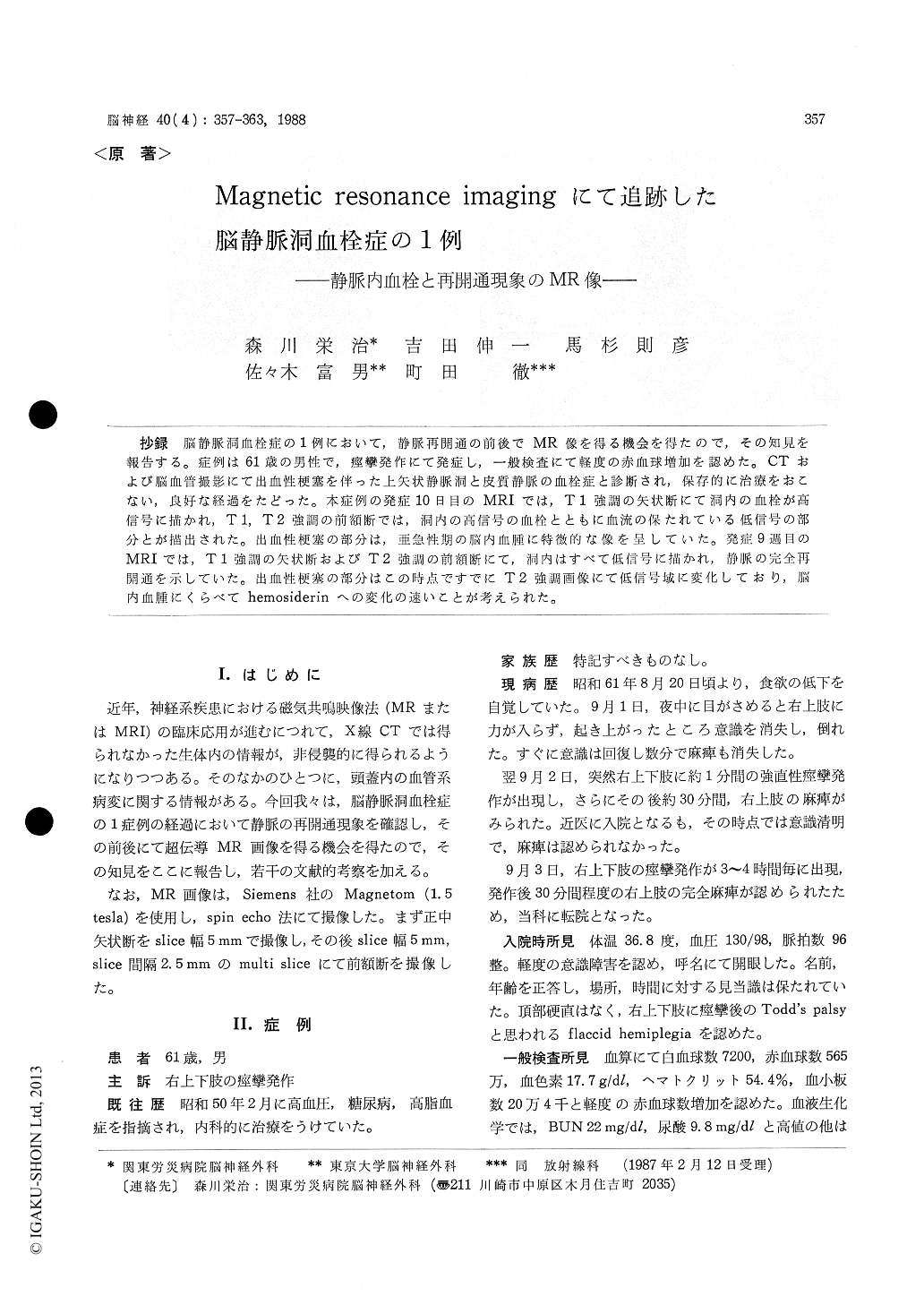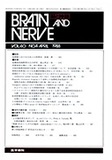Japanese
English
- 有料閲覧
- Abstract 文献概要
- 1ページ目 Look Inside
抄録 脳静脈洞血栓症の1例において,静脈再開通の前後でMR像を得る機会を得たので,その知見を報告する。症例は61歳の男性で,痙攣発作にて発症し,一般検査にて軽度の赤血球増加を認めた。CTおよび脳血管撮影にて出血性梗塞を伴った上矢状静脈洞と皮質静脈の血栓症と診断され,保存的に治療をおこない,良好な経過をたどった。本症例の発症10日目のMRIでは,T1強調の矢状断にて洞内の血栓が高信号に描かれ,T1, T2強調の前額断では,洞内の高信号の血栓とともに血流の保たれている低信号の部分とが描出された。出血性梗塞の部分は,亜急性期の脳内血腫に特徴的な像を呈していた。発症9週目のMRIでは,T1強調の矢状断およびT2強調の前額断にて,洞内はすべて低信号に描かれ,静脈の完全再開通を示していた。出血性梗塞の部分はこの時点ですでにT2強調画像にて低信号域に変化しており,脳内血腫にくらべてhemosiderinへの変化の速いことが考えられた。
Magnetic resonance images of a case of superior sagittal sinus thrombosis before and after com-plete recanalization are presented.
The patient was a 61-year-old man with two days history of intermittent right hemiconvulsion followed by post-ictal hemiplegia. Mild erythro-cytosis was noted on admission. CT scans re-vealed left frontal hemorrhagic infarction with empty delta sign in the middle portion of the superior sagittal sinus. Left carotid angiogram showed occlusion of two frontal cortical veins and retrograde filling of these veins into the cavernous sinus. Lack of filling of the middle and anterior part of the superior sagittal sinus was noted. These studies led to the diagnosis of superior sagittal sinus thrombosis associatedwith hemorrhagic infarction.
He was treated with intravenous infusion of low molecular dextran and venesection. Neither heparin, urokinase, hyperosmolar solusions nor steroids were used because of the presence of hemorrhagic infarction and of the lack of signs of increased intracranial pressure. He completely recovered neurologically and recanalization of the superior sagittal sinus was confirmed angio-graphically eight weeks after the onset.
Magnetic resonance images were taken with a Siemens 1.5 T Magnetom scanner using spin-echo pulse sequences.
A T 1-weighted mid-sagittal magnetic resonance image ten days after the onset showed hyper-intensity in the middle part of the superior sagittal sinus which corresponded to the thrombus. Both T 1 and T 2 weighted coronal images revealed a small area of hypointensity indicating the ex-istence of residual blood flow in the superior sagittal sinus in addition to the thrombus both in the sinus and in the cortical vein. Hemor-rhagic infarction in the left frontal subcortexshowed typical appearance of intracerebral he-matoma of the subacute stage on T 2-weighted images : round hyperintensity with hypointensity rim surrounded by hyperintensity edema.
T 1-weighted mid-sagittal and T 2-weighted co-ronal images nine weeks after the onset showed disappearance of hyperintensity in the sinus, which indicated the occurrence of complete re-canalization. The figure of the left subcortical hematoma already turned into hypointensity on the T2-weighted images. This change in intensity was probably caused by the change of methemo-globin into hemosiderin, and this process may occur early in case of hemorrhagic infarction as compared to intracerebral hematoma.
With the capability of visualizing both throm-bus and blood flow directly and non-invasively, high field magnetic resonance imaging was considered to be a modality of choice for the diagnosis and follow-up study of cerebral sinus thrombosis.

Copyright © 1988, Igaku-Shoin Ltd. All rights reserved.


